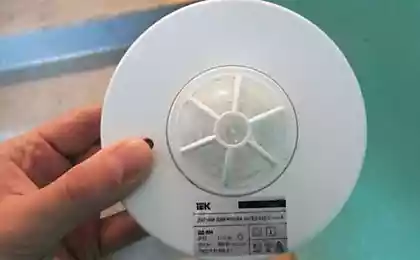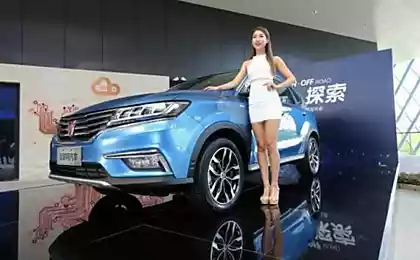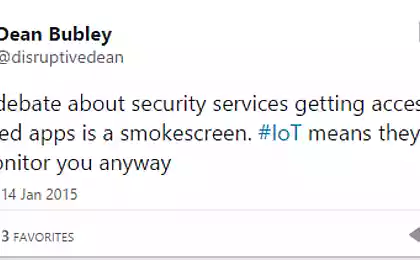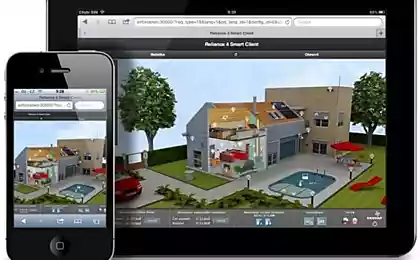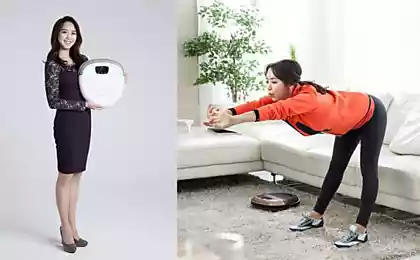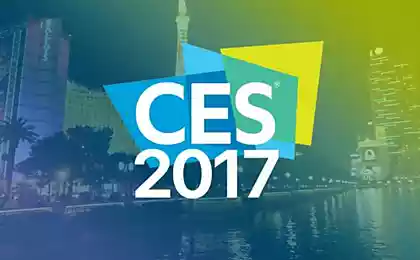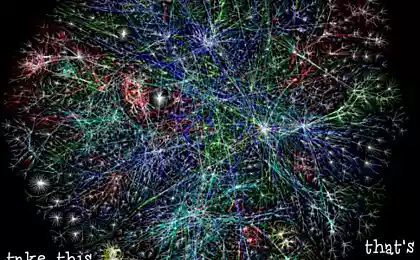1023
We connected devices
"Internet of Things" - the fresh, tasty, and perhaps often used phrase for any self-respecting IT-companies.
Industrial manufacturers, major retailers, commercial players in the healthcare market - each of these sections of the market sees its own path to how to get the most and take the highest percentage of buyers of small (depends), energy efficiency (not always) gadgets.

All the technological industry so excited happening in the IoT , that the general level glove called hysteria.
Comes to the ridiculous: Cisco is trying to make into use a slightly modified term - «Internet of Everything» (as was the case in the story of «Human Network», came out so-so). Qualcomm have some of their own solutions, Intel intends to go directly to the creation of platforms, while Apple and Google behind high fences are developing increasingly complex strategies and tactics.

As with any other trend in the past, before the IoT, has already appeared a flock of specialized shows, exhibitions, accelerators and venture capital funds, local meetings at the district and "do it yourself" mugs. Unprecedented - consulting companies such as McKinsey, Accenture, KPMG began organizing their own IoT-oriented departments and development of "best" practices.
That, so far, most surprising - is the lack of a universal, clear and simple definition of what the benefits of each of us, in the person of the buyer, will be familiarized with the device and further immersion in the IoT. Not to mention what it is.
At the same time, we already see and denial of a number of members from the trend and evidence of this, for various reasons: someone called Glasshole (Glass / Asshole, name-calling for native Google), while others do not see any sense to continue carry a fitness device to learn a lot about yourself (or not so) new. At the same time, they continue to actively sold, and they are not as actively refuse.
Consumer (we're above it) do not understand the phenomenon of machines communicating with each other (now it is called «M2M»), or what "data cloud" - for the most part, yet it SkyNet, once HAL9000. After all learned primarily from traditional media that the NSA sees all, and Facebook - everyone and still have time to earn money for our with you data and behavior, the basic task of IoT companies - is to convince the buyer that the product can be trust. Especially when it comes to our homes and our single bodies.

There is another difficulty - for all of us it is still toy rather than a comprehensive philosophy that can change the world, regardless of our level of preparedness. Perception IoT as a "passing trend" reduces the overall significance of the events. Worth a look - and it becomes clear that the phenomenon is much broader. However, many manufacturers are wrong too, dictating the behavior of short-term behavior of the buyer - this is hardly the way to a brighter future.
And these are not right marketing company that advertises another "genie in a bottle," based on the "big data", analyzed in real time, with the help of our behavior or standardized model. It becomes quite clear that we are waiting for the era.

We all understand that the technology platforms that interact in the same mode, with the same speed, complementing each other in a network of distributed computing - is something very exciting. But something is missing in all our ideas on how this can, should, and will actually look like.
But in fact, IoT may be the culmination of the development of modern technology - the moment when, finally, you can connect any device with your body, digitize their own lives, and perhaps expand their own capabilities. After all, this is exactly what a worthwhile endeavor: to extract for themselves the best of that at the moment offers us the IT-sector as such.
With the ability to analyze the context in which there is a per-user basis, and the world in which he is surrounded, right now we have the opportunity to create a single information space for data, cars and people. Augmented reality applications know for sure what you are doing and how to help you - a future in which we must bring IoT.

In the прошлогодней Book «Century Context: Mobile, Sensors, Data and Future private ', Robert Scoble and Shel Israel called the most exciting things we do not know. And it's not about the uncertainty of the future, but the more mundane things - the fact that no existing capacity can not do, and the tone of innovation rather ask existing restrictions (protocols, infrastructure). Sequence that begins with smart watches, bracelets, smart home devices, each of which sends its data in the notorious cloud, where they are analyzed and create conditions for the user's response. Or something like that.
Existing devices, existing social and figures about us, our friends, colleagues, family members and connections within the structure, being included in the analysis process and absorption of this information. Already obtained a little more than just a "trend».
Another interesting detail concerning the IoT is that it is little more than just "things».

Right now we are witnessing develops following a technological marvel, actually - a new paradigm. If year by 2020 from 50 to 100 (projected) billion devices will actually be connected to the network, you can not lose sight of the fact that in the center of it all one way or another there must be a user - a person who uses all these multiple devices, applications and services. In the first place, for the integration of its real "I" and retrieving digital unless benefits is a minimum of information.
Developers around the world have been working for years to progressively build infrastructure and interoperability between the main centers of attraction on the Internet, and in fact because of this, are we talking about IoT - because initially no other purpose than to compound billions of people together, no of them did not pursue.
Today we are in a situation that forces us to unite around smart cities, buildings, cars and, above all, the sensors are connected to our bodies. IoT - only a temporary name "connected to the human body».
Of course, we are interested in collecting data, intellectual interaction and predictive analysis, as well as deep data optimization and how to connect them around ourselves, and physical objects around us as well - pre-existing conditions and prerequisites for the emergence of this.
In health care, industrial networks, transport, energy and many other industries, IoT will increasingly go beyond what we originally imagined possible. Would like to see us waiting for a brand new fundamental innovations, technologies, applications and business models of successful existence.
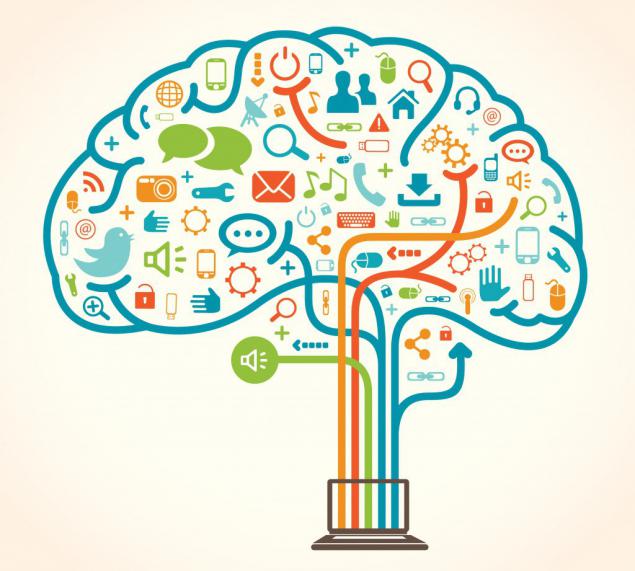
We should also talk about health care, because it is in connection with the sensors can be placed not only and not so much on our bodies as home or on the street. Heck, they soon will be in our bodies, to analyze the biological and anatomical information of the body, sending information to analyze the results of which should lead to improve the quality of services, and therefore - the continuation of human life.
Technological foundation on and through which is developing all the "Internet of Things", there is enough time, we only watch as was overcome a number of obstacles, which has allowed billions of devices to interact with the user's own platforms and between themselves. A striking example of IPv6, allowing to build targeted schemes are capable of withstanding such data streams.
Not to mention the problems of miniaturization and power consumption, as well as energy efficiency. Perhaps it would even be wrong to say that we have achieved here own purposes.
Well, the primary scope of work - these are the standards by which the device can perform its function. Most of them already exist, such as IEEE 802.3 «Standart for Ethernet» and IEEE 802.11 [2] , which means all« wi-fi »products on the market. Further improvements are needed in the architecture, clouds, communication platforms, not to mention the areas of distributed computing, privacy and security. IEEE P2413 «Draft Standart for an Archutectural Framework for the Internet of Things», for example, created an architectural framework for cross-domain interactions that will help future systems to communicate regardless of the platform or the original method for implementing a particular device.
No universal solutions, but they may appear.
In preparing the material used labor from: TechCrunch , The Verge a >, Wired Magazine
Source: geektimes.ru/post/243525/
Industrial manufacturers, major retailers, commercial players in the healthcare market - each of these sections of the market sees its own path to how to get the most and take the highest percentage of buyers of small (depends), energy efficiency (not always) gadgets.

All the technological industry so excited happening in the IoT , that the general level glove called hysteria.
Comes to the ridiculous: Cisco is trying to make into use a slightly modified term - «Internet of Everything» (as was the case in the story of «Human Network», came out so-so). Qualcomm have some of their own solutions, Intel intends to go directly to the creation of platforms, while Apple and Google behind high fences are developing increasingly complex strategies and tactics.

As with any other trend in the past, before the IoT, has already appeared a flock of specialized shows, exhibitions, accelerators and venture capital funds, local meetings at the district and "do it yourself" mugs. Unprecedented - consulting companies such as McKinsey, Accenture, KPMG began organizing their own IoT-oriented departments and development of "best" practices.
That, so far, most surprising - is the lack of a universal, clear and simple definition of what the benefits of each of us, in the person of the buyer, will be familiarized with the device and further immersion in the IoT. Not to mention what it is.
At the same time, we already see and denial of a number of members from the trend and evidence of this, for various reasons: someone called Glasshole (Glass / Asshole, name-calling for native Google), while others do not see any sense to continue carry a fitness device to learn a lot about yourself (or not so) new. At the same time, they continue to actively sold, and they are not as actively refuse.
Consumer (we're above it) do not understand the phenomenon of machines communicating with each other (now it is called «M2M»), or what "data cloud" - for the most part, yet it SkyNet, once HAL9000. After all learned primarily from traditional media that the NSA sees all, and Facebook - everyone and still have time to earn money for our with you data and behavior, the basic task of IoT companies - is to convince the buyer that the product can be trust. Especially when it comes to our homes and our single bodies.

There is another difficulty - for all of us it is still toy rather than a comprehensive philosophy that can change the world, regardless of our level of preparedness. Perception IoT as a "passing trend" reduces the overall significance of the events. Worth a look - and it becomes clear that the phenomenon is much broader. However, many manufacturers are wrong too, dictating the behavior of short-term behavior of the buyer - this is hardly the way to a brighter future.
And these are not right marketing company that advertises another "genie in a bottle," based on the "big data", analyzed in real time, with the help of our behavior or standardized model. It becomes quite clear that we are waiting for the era.

We all understand that the technology platforms that interact in the same mode, with the same speed, complementing each other in a network of distributed computing - is something very exciting. But something is missing in all our ideas on how this can, should, and will actually look like.
But in fact, IoT may be the culmination of the development of modern technology - the moment when, finally, you can connect any device with your body, digitize their own lives, and perhaps expand their own capabilities. After all, this is exactly what a worthwhile endeavor: to extract for themselves the best of that at the moment offers us the IT-sector as such.
With the ability to analyze the context in which there is a per-user basis, and the world in which he is surrounded, right now we have the opportunity to create a single information space for data, cars and people. Augmented reality applications know for sure what you are doing and how to help you - a future in which we must bring IoT.

In the прошлогодней Book «Century Context: Mobile, Sensors, Data and Future private ', Robert Scoble and Shel Israel called the most exciting things we do not know. And it's not about the uncertainty of the future, but the more mundane things - the fact that no existing capacity can not do, and the tone of innovation rather ask existing restrictions (protocols, infrastructure). Sequence that begins with smart watches, bracelets, smart home devices, each of which sends its data in the notorious cloud, where they are analyzed and create conditions for the user's response. Or something like that.
Existing devices, existing social and figures about us, our friends, colleagues, family members and connections within the structure, being included in the analysis process and absorption of this information. Already obtained a little more than just a "trend».
Another interesting detail concerning the IoT is that it is little more than just "things».

Right now we are witnessing develops following a technological marvel, actually - a new paradigm. If year by 2020 from 50 to 100 (projected) billion devices will actually be connected to the network, you can not lose sight of the fact that in the center of it all one way or another there must be a user - a person who uses all these multiple devices, applications and services. In the first place, for the integration of its real "I" and retrieving digital unless benefits is a minimum of information.
Developers around the world have been working for years to progressively build infrastructure and interoperability between the main centers of attraction on the Internet, and in fact because of this, are we talking about IoT - because initially no other purpose than to compound billions of people together, no of them did not pursue.
Today we are in a situation that forces us to unite around smart cities, buildings, cars and, above all, the sensors are connected to our bodies. IoT - only a temporary name "connected to the human body».
Of course, we are interested in collecting data, intellectual interaction and predictive analysis, as well as deep data optimization and how to connect them around ourselves, and physical objects around us as well - pre-existing conditions and prerequisites for the emergence of this.
In health care, industrial networks, transport, energy and many other industries, IoT will increasingly go beyond what we originally imagined possible. Would like to see us waiting for a brand new fundamental innovations, technologies, applications and business models of successful existence.

We should also talk about health care, because it is in connection with the sensors can be placed not only and not so much on our bodies as home or on the street. Heck, they soon will be in our bodies, to analyze the biological and anatomical information of the body, sending information to analyze the results of which should lead to improve the quality of services, and therefore - the continuation of human life.
Technological foundation on and through which is developing all the "Internet of Things", there is enough time, we only watch as was overcome a number of obstacles, which has allowed billions of devices to interact with the user's own platforms and between themselves. A striking example of IPv6, allowing to build targeted schemes are capable of withstanding such data streams.
Not to mention the problems of miniaturization and power consumption, as well as energy efficiency. Perhaps it would even be wrong to say that we have achieved here own purposes.
Well, the primary scope of work - these are the standards by which the device can perform its function. Most of them already exist, such as IEEE 802.3 «Standart for Ethernet» and IEEE 802.11 [2] , which means all« wi-fi »products on the market. Further improvements are needed in the architecture, clouds, communication platforms, not to mention the areas of distributed computing, privacy and security. IEEE P2413 «Draft Standart for an Archutectural Framework for the Internet of Things», for example, created an architectural framework for cross-domain interactions that will help future systems to communicate regardless of the platform or the original method for implementing a particular device.
No universal solutions, but they may appear.
In preparing the material used labor from: TechCrunch , The Verge a >, Wired Magazine
Source: geektimes.ru/post/243525/




